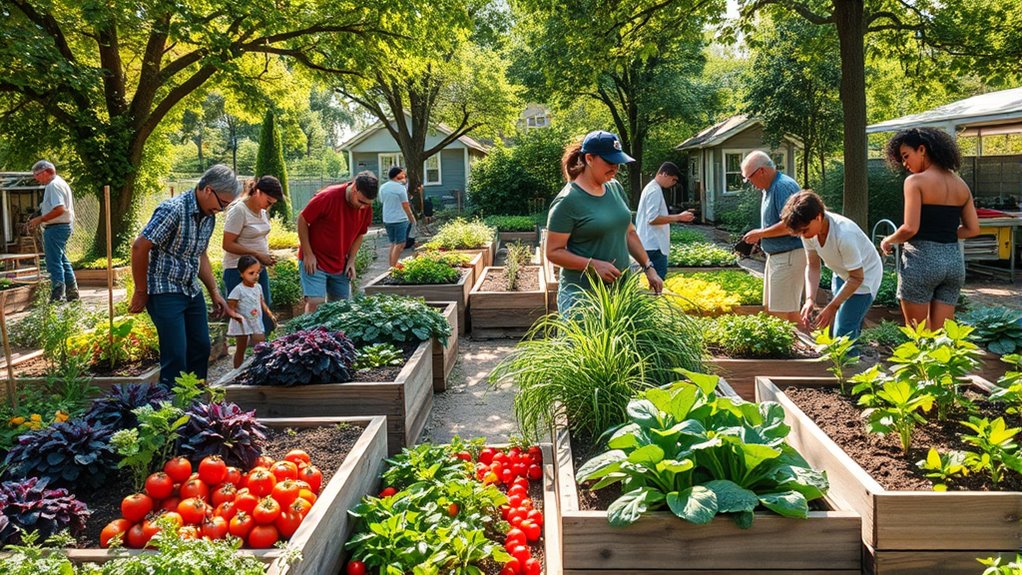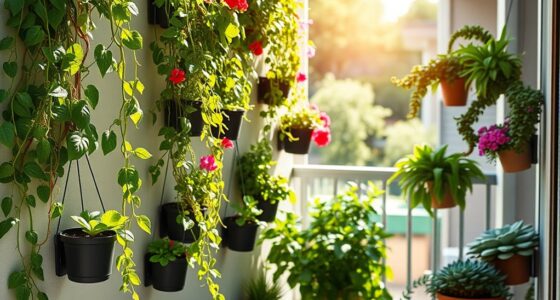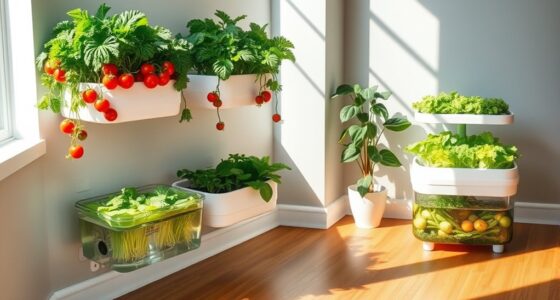Sharing a garden with neighbors allows you to grow more produce, foster stronger community bonds, and create a sustainable outdoor space. By collaborating on composting, design, and resource sharing, you can make the most of your land and reduce waste. It’s a great way to learn new skills, save money, and enjoy a vibrant, productive garden together. Keep exploring how you can turn your shared space into a thriving neighborhood hub.
Key Takeaways
- Form a shared community garden to maximize space, resources, and crop variety through neighbor collaboration.
- Establish composting systems to reduce waste and improve soil health collectively.
- Design the garden with raised beds, vertical gardens, and designated zones for efficient use.
- Share tips, seeds, and tools to build skills and foster stronger neighbor connections.
- Plan for long-term maintenance and community involvement to ensure sustainability and ongoing growth.

Have you ever considered how sharing gardens can transform your outdoor space into a thriving community hub? When you team up with neighbors to create a shared garden, you open the door to endless possibilities for growing more and connecting more deeply with those around you. One of the key benefits of a community garden is the opportunity to implement effective composting techniques. Instead of tossing food scraps and yard waste into the trash, you can establish compost bins that everyone contributes to and benefits from. This reduces waste and produces nutrient-rich soil that boosts plant growth naturally. Proper composting doesn’t have to be complicated; turning organic waste regularly, maintaining the right moisture levels, and balancing greens and browns will yield compost faster and improve your garden’s health. Incorporating these composting techniques into your shared gardening routine helps everyone learn and participate, making the process both educational and sustainable. Additionally, understanding long-term financial planning for garden supplies or enhancements can help sustain the community garden over time.
In addition to composting, collaborating on garden design ideas can make your shared space more functional and inviting. When working with neighbors, you can experiment with different layouts, such as raised beds, vertical gardening, or designated zones for herbs, vegetables, and flowers. Combining your ideas allows for a more diverse and productive garden that maximizes available space. For example, you might designate a corner for a compost station, a sunny patch for vegetables, or shaded areas for shade-loving plants. Sharing design ideas also encourages creativity and resourcefulness—reusing pallets, repurposing containers, or even creating communal seating areas enhances the overall aesthetic and usability of the garden. Open communication about garden design guarantees everyone’s needs and preferences are considered, fostering a sense of ownership and pride.
Working together on a shared garden isn’t just about planting and harvesting; it’s about building relationships and creating a sense of community. Regularly exchanging tips, seeds, or produce strengthens bonds and encourages knowledge sharing. As you implement composting techniques and develop innovative garden design ideas, you’ll find that the collective effort leads to a more productive and enjoyable outdoor space. Plus, you’ll save money by pooling resources and sharing tools. The collaborative process also makes gardening more accessible for newcomers, who can learn from experienced neighbors and gain confidence in their skills. Ultimately, a shared garden transforms a patch of land into a vibrant community asset—where everyone contributes, learns, and reaps the benefits of a lush, sustainable outdoor space.
Frequently Asked Questions
How Do I Resolve Disputes With Neighbors Over Garden Space?
When disputes arise over garden space, you should start by communicating openly with your neighbors, emphasizing good garden etiquette. Discuss your planting schedules and listen to their concerns. Find a compromise that respects everyone’s needs and boundaries. Setting clear agreements on shared areas can prevent future conflicts. Remember, maintaining a friendly attitude and focusing on cooperation helps resolve disagreements smoothly, ensuring everyone enjoys their gardening experience.
What Are the Legal Rights Involved in Shared Gardening?
When you share gardening space, your legal rights depend on property ownership and agreements. You have the right to use the land if you’re a property owner or have a lease. Be aware of liability concerns; you could be responsible for injuries or damages. It’s wise to create a written agreement covering shared responsibilities, usage rights, and liability limits to avoid disputes and clarify rights.
How Can I Ensure Fair Distribution of Harvests?
Did you know that 78% of successful community gardens use harvest sharing to guarantee fairness? To keep things equitable, set clear agreements on harvest sharing and implement crop rotation to prevent disputes over produce. Communicate openly with neighbors, document agreements, and consider using a harvest schedule. This way, everyone benefits fairly, and the garden thrives as a cooperative effort.
What Safety Precautions Should Be Taken in Shared Gardens?
You should prioritize garden safety by wearing gloves and protective gear when handling plants or tools. Keep pathways clear to prevent accidents, and store tools properly after use to avoid injuries. Practice good tool management by checking for sharp edges and rust, and make certain everyone knows how to use them safely. Regularly inspect the garden for hazards like broken fencing or exposed roots, and encourage open communication about safety concerns.
How Do I Start a Community Garden Co-Op?
Getting a community garden co-op off the ground is just the tip of the iceberg. You need to gather neighbors interested in composting techniques and garden tool sharing. Start by organizing a meeting to discuss goals, responsibilities, and rules. Create a shared plan for planting and maintenance. Clear communication is key—think of it as planting seeds for a thriving, cooperative space where everyone benefits and grows together.
Conclusion
By sharing gardens with your neighbors, you create more than just a bountiful harvest—you foster a true sense of community. As you work together, you’ll discover that collaboration turns a simple plot into a thriving oasis, reminiscent of the cooperative spirit seen in historic town squares. Remember, in this modern age, it’s the collective effort that truly cultivates abundance and connection. Embrace the garden co-op, and watch how your shared efforts bloom into something timeless.









